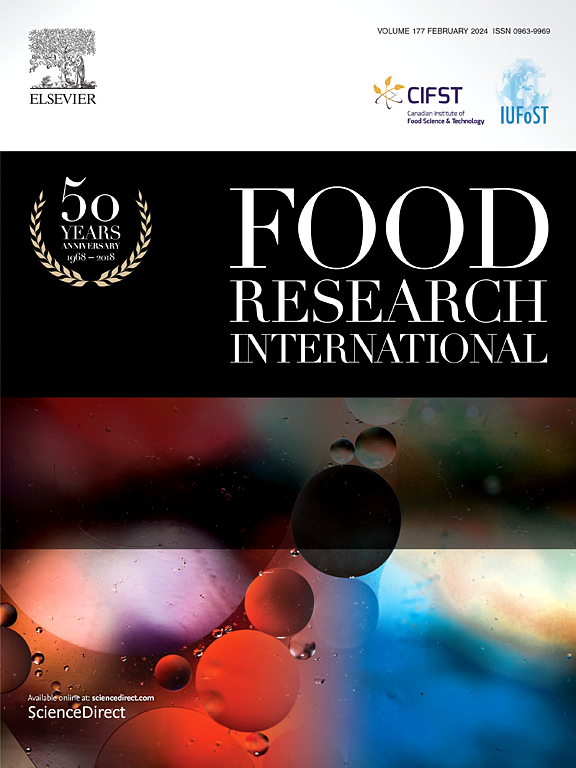蜂蜜加工对黄芪汤剂中纳米颗粒的影响:自组装、生物利用度和生物活性
IF 7
1区 农林科学
Q1 FOOD SCIENCE & TECHNOLOGY
引用次数: 0
摘要
与黄芪(AR)相比,蜂蜜加工的黄芪(HAR)在补气(增强身体的生命能量,增加抗疲劳能力,改善营养吸收,增强疾病防御能力)和免疫调节活性方面都具有优越的功效。现有研究主要将HAR的生物活性增强归因于化学成分的定量变化,而本研究将重点放在煎煮功效的物质基础(纳米颗粒)上,研究蜂蜜加工对这些纳米颗粒的理化性质、化学成分、自组装、生物利用度和生物活性的影响。我们的研究结果表明,AR煎煮衍生纳米颗粒(ARD-NP)和HAR煎煮衍生纳米颗粒(HARD-NP)主要是通过氢键和疏水相互作用使多糖、蛋白质和小分子自组装而形成的。与ARD-NP相比,HARD-NP含有更高浓度的多糖和黄酮类化合物,同时具有更小的粒径、更窄的粒径分布和更好的结构稳定性。值得注意的是,蜂蜜加工显著改善了纳米颗粒中四种代表性黄酮类化合物(CAG、ON、CA和FMN)的肠道吸收和口服生物利用度,从而增强了补气的生物活性。本研究创新性地以中药煎剂中常见的纳米颗粒为研究对象,为中药复方合剂增强疗效的机制提供了新的视角。为医药食品同源植物的加工及新型功能食品的开发提供科学参考。本文章由计算机程序翻译,如有差异,请以英文原文为准。

The effects of honey processing on nanoparticles in Astragali Radix decoction: Self-assembly, bioavailability, and bioactivity
Compared with Astragali Radix (AR), honey-processed Astragali Radix (HAR) exhibits superior efficacy in both Qi-tonifying (enhancement of the body's vital energy to increase fatigue resistance, improve nutrient absorption, and strengthen defenses against illnesses) and immunomodulatory activity. While existing researches have predominantly attributed HAR's enhanced bioactivity to quantitative changes in chemical constituents, this study focused on the material basis of decoction efficacy (nanoparticles), and investigated the effects of honey processing on the physicochemical properties, chemical composition, self-assembly, bioavailability, and bioactivity of these nanoparticles. Our findings revealed that both AR decoction-derived nanoparticles (ARD-NP) and HAR decoction-derived nanoparticles (HARD-NP) were primarily formed through the self-assembly of polysaccharides, protein, and small molecules via hydrogen bonding and hydrophobic interactions. In comparison to ARD-NP, HARD-NP contained higher concentrations of polysaccharides and flavonoids, while demonstrating smaller particle size, narrower size distribution, and superior structural stability. Notably, honey processing significantly improved the intestinal absorption and oral bioavailability of four representative flavonoids (CAG, ON, CA and FMN) in the nanoparticles, leading to enhanced bioactivity in Qi-tonifying. This study innovatively focuses on the nanoparticles commonly found in decoctions as the subject of investigation, providing a new perspective on the mechanisms underlying the enhanced efficacy of HAR. Furthermore, it provides scientific references for the processing of medicine food homology plants, as well as the development of novel functional foods.
求助全文
通过发布文献求助,成功后即可免费获取论文全文。
去求助
来源期刊

Food Research International
工程技术-食品科技
CiteScore
12.50
自引率
7.40%
发文量
1183
审稿时长
79 days
期刊介绍:
Food Research International serves as a rapid dissemination platform for significant and impactful research in food science, technology, engineering, and nutrition. The journal focuses on publishing novel, high-quality, and high-impact review papers, original research papers, and letters to the editors across various disciplines in the science and technology of food. Additionally, it follows a policy of publishing special issues on topical and emergent subjects in food research or related areas. Selected, peer-reviewed papers from scientific meetings, workshops, and conferences on the science, technology, and engineering of foods are also featured in special issues.
 求助内容:
求助内容: 应助结果提醒方式:
应助结果提醒方式:


